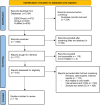Can oral health care be a gateway to improve cardiovascular disease? A scoping review
- PMID: 38846319
- PMCID: PMC11155301
- DOI: 10.3389/froh.2024.1364765
Can oral health care be a gateway to improve cardiovascular disease? A scoping review
Abstract
Background: Cardiovascular diseases (CVDs) are a significant cause of morbidity and mortality worldwide, resulting in a high socioeconomic burden. Growing evidence has shown a link between oral diseases and several chronic conditions including CVDs. The focus of this review is to investigate and summaries the evidence surrounding oral health interventions and their potential impact on reducing both the risk and/or severity of CVDs.
Methods: A scoping review was conducted to examine oral health interventions for managing CVD outcomes and risks. The review adhered to the Joanna Briggs Institute (JBI) framework for evidence synthesis and followed the reporting standards outlined by the Preferred Reporting Items for Systematic Reviews and Meta-analysis- extension to Scoping Review (PRISMA-ScR). A systematic search across EBSCOhost, PubMed, and Scopus databases from 2012 to 2024 was utilized to identify relevant studies. Inclusion criteria focused on English language articles with a sample size of at least 50, evaluating the impact of oral health interventions on CVD outcomes.
Results: Out of the initial 2,154 studies identified in the search, 12 studies met the inclusion and exclusion criteria and were included in the final analysis. Overall, the studies revealed that along with surgical and non-surgical periodontal therapy, regular oral hygiene care practices, including toothbrushing, tongue brushing, and flossing, significantly reduced the risk of cardiovascular events and mortality. These interventions in patients with or without CVD baseline have shown a decrease in CVD risk markers as well as a reduction in bacterial colonization. Similarly, consistent oral hygiene routines, combined with regular dental visits, were associated with a lower risk of heart failure and CVD risk mortality.
Conclusion: The evidence extracted from this review suggests that periodontal therapy, regular dental cleaning, and re-enforcing of oral health regimes can stabilize oral health conditions and subsequently improve CVD progression/risks. However, limited to no evidence exists regarding the therapeutic effects of oral health promotion in managing CVD markers and its direct impact on disease outcomes, warranting further investigation.
Keywords: cardiovascular diseases; cardiovascular severity; oral health care; oral health promotion; oral hygiene care; periodontal disease; periodontitis.
© 2024 Usmani, de Courten and Hanna.
Conflict of interest statement
The authors declare that the research was conducted in the absence of any commercial or financial relationships that could be construed as a potential conflict of interest.
Figures


Similar articles
-
Beyond the black stump: rapid reviews of health research issues affecting regional, rural and remote Australia.Med J Aust. 2020 Dec;213 Suppl 11:S3-S32.e1. doi: 10.5694/mja2.50881. Med J Aust. 2020. PMID: 33314144
-
The Role of Visualization in Estimating Cardiovascular Disease Risk: Scoping Review.JMIR Public Health Surveill. 2024 Oct 14;10:e60128. doi: 10.2196/60128. JMIR Public Health Surveill. 2024. PMID: 39401079 Free PMC article.
-
Periodontal therapy for primary or secondary prevention of cardiovascular disease in people with periodontitis.Cochrane Database Syst Rev. 2019 Dec 31;12(12):CD009197. doi: 10.1002/14651858.CD009197.pub4. Cochrane Database Syst Rev. 2019. Update in: Cochrane Database Syst Rev. 2022 Oct 4;10:CD009197. doi: 10.1002/14651858.CD009197.pub5. PMID: 31887786 Free PMC article. Updated.
-
Dietary glycation compounds - implications for human health.Crit Rev Toxicol. 2024 Sep;54(8):485-617. doi: 10.1080/10408444.2024.2362985. Epub 2024 Aug 16. Crit Rev Toxicol. 2024. PMID: 39150724
-
Barriers and facilitators of cardiovascular disease prevention services for women with prior gestational diabetes or hypertensive disorders of pregnancy in low-income, middle-income and high-income settings: a scoping review protocol.BMJ Open. 2024 Aug 17;14(8):e084212. doi: 10.1136/bmjopen-2024-084212. BMJ Open. 2024. PMID: 39153794 Free PMC article.
Cited by
-
Oral Health and Cardiovascular Disease - A Scoping Review of Assessment Methods, Risk Factors, and Prognosis.Circ Rep. 2025 Mar 1;7(4):223-230. doi: 10.1253/circrep.CR-24-0187. eCollection 2025 Apr 10. Circ Rep. 2025. PMID: 40213795 Free PMC article.
References
-
- WHO. Cardiovascular diseases (CVDs). (2021) Available online at: https://www.who.int/news-room/fact-sheets/detail/cardiovascular-diseases... (Accessed January 12, 2024).
-
- WHO. Oral Health. Available online at: https://www.who.int/news-room/fact-sheets/detail/oral-health (2023).
-
- Bourgeois D, Inquimbert C, Ottolenghi L, Carrouel F. Periodontal pathogens as risk factors of cardiovascular diseases, diabetes, rheumatoid arthritis, cancer, and chronic obstructive pulmonary disease—is there cause for consideration? Microorganisms. (2019) 7(10):424. 10.3390/microorganisms7100424 - DOI - PMC - PubMed
Publication types
LinkOut - more resources
Full Text Sources
Miscellaneous

